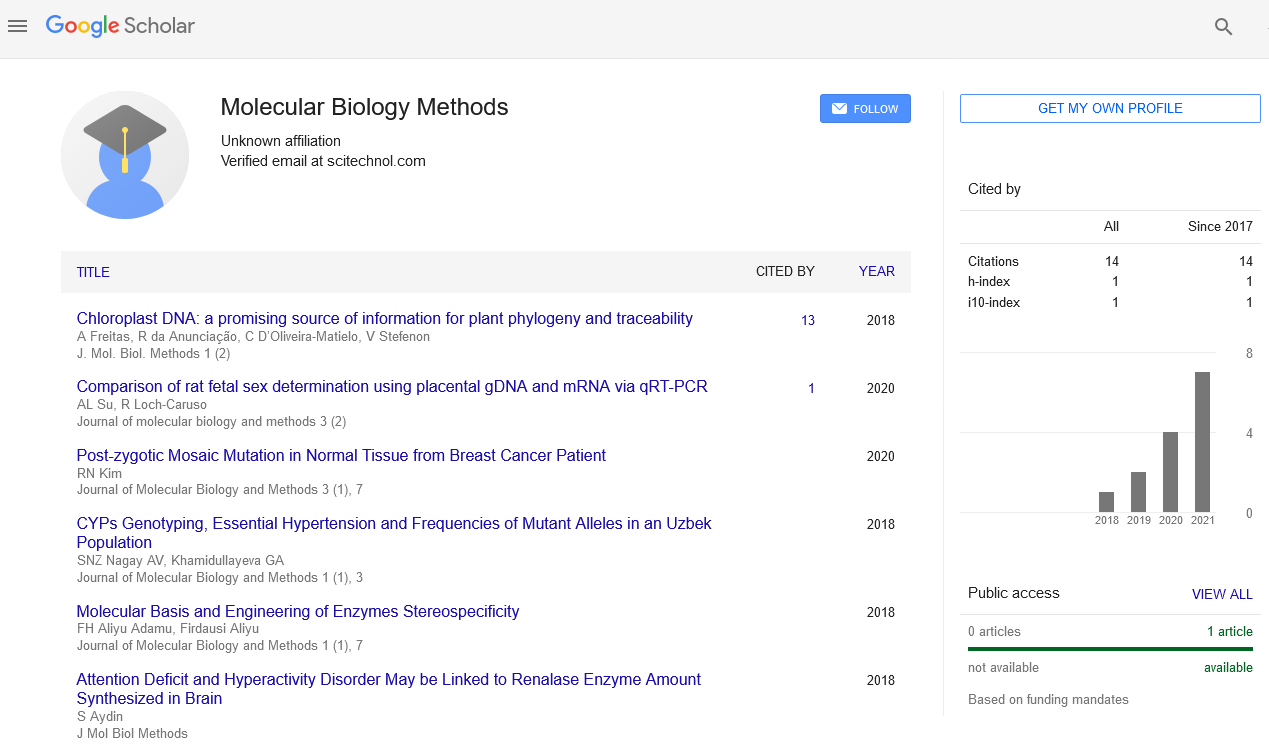Commentary, J Mol Biol Methods Vol: 5 Issue: 1
Development of Protease-Resistant Prion Protein in Cell-Free Systems
Rachel Cohen-Kupiec*,
Otto-Warburg-Center for Agricultural Biotechnology, The Hebrew University of Jerusalem, Faculty of Agriculture, PO Box 12, Rehovot 76100, Israel
Corresponding Author:
Rachel Cohen-Kupiec
Otto-Warburg-Center for Agricultural Biotechnology, The Hebrew University of Jerusalem, Faculty of Agriculture, PO Box 12, Rehovot 76100, Israel
E-mail: cohenk@agri.ac.il
Received date: December31, 2021, Manuscript No. JMBM-22-59448;
Editor assigned date: January 03, 2022, Manuscript No. JMBM-22-59448;
Reviewed date: January 13, 2022, Manuscript No. JMBM-22-59448;
Revised date: January 24, 2022, Manuscript No. JMBM-22-59448 (R);
Published date: January 31, 2022, DOI:10.4172/JMBM.1000111
Keywords: Monomers, Proteinase, Amyloids
Introduction
In contagious spongiform encephalopathies (TSE) or on the other hand prion sicknesses, the endogenous protease-delicateprion protein (PrP-sen) of the host is changed over to anstrange pathogenic structure that has a trademarkhalfway protease obstruction (PrP-res). Studies with cellfree responses show that the PrP-res itself can straightforwardly incite this change of PrP-sen. This PrPres incited change response is exceptionally explicit inways that could account at the sub-atomic level for TSEspecies obstructions, polymorphism boundaries, and strains.Not just has this response been noticed utilizing for the most part decontaminated PrP-sen and PrP-res reactants, yet additionally in TSEinfected mind cuts. The change component seems to include both the limiting of PrP-sen topolymeric PrP-res and a conformational change thatbrings about consolidation into the PrP-res polymer. The gathering of unusually protease-safe prion protein (PrP-res) is normal to contagious spongiform encephalopathies (TSE). The level of obstruction of PrPres can differ contingent on the TSE strain and host species (1,2, 75), yet the TSE-related types of PrPres are extensively more impervious to proteinase K than is the relating ordinary PrP isoform (PrP-sen or PrPc). Other than having upgraded protease-opposition, the differentstrange TSE-related types of PrP-res (eg. PrPSc,PrPCJD and PrPBSE) structure insoluble totals and have ahigher beta sheet content than PrP-sen.
Self-Propagating PrP-res Conformations as a Possible
Strains of TSE specialists can be recognized based onspecies tropism, hatching period, clinical illness,neuropathological signs and PrP-res conveyancein mind tissue. Various TSE strainshave been archived even inside isogenic has. Thisreality represents a fascinating test for the protein-in particulartheory for the irresistible specialist: It requires that the"legacy" or spread of the specialist strain dif ferencesshould be intervened by stable varieties in PrP-res structureinstead of changes in a specialist explicit nucleic corrosive.Underlying contrasts in PrP-res have been connected withvarious strains of TSEs. Especiallyprominent are the various types of PrP-res related withthe hyper (HY) and languid (DY) strains of hamster-adjustedcontagious mink encephalopathy (TME). Albeit thesePrP-res structures are both gotten from Syrian hamster PrP,they are severed distinctively by PK. This recommends that they vary in conformity instead of covalent construction and this has been affirmed by FTIR examination. Moreover, when brooded with hamster PrP-senatoms, HY and DY PrP-res reliably actuate the development of strain-explicit PrP-res transformation items further more, along these lines engender themselves by a direct, non geneticinstrument. These information gave the first immediate proof that strain-explicit PrP-res polymers with the same amino corrosive arrangement however unique three dimensional designs or compliances are fit for self-proliferation. This is reliable with the likelihood that the self-engendering ofPrP-res polymers is an atomic reason for scrapie strains. Additionally steady with this thought is a new report appearingthat the entry of specialist got from various sorts offamilial CJD into mice caused the gathering of PrP-reswith evidently particular conformities.Connecting Scrapie Infectivity With Converting Activity,Protease-Resistance and Aggregation of PrP-res Considering that PrP-res may be the TSE specialist which depends on the changing over action for its spread in the host, we tried whether the impacts of GdnHCl on the changing over movement, PK-obstruction and collection of PrPSc mayconcur with consequences for scrapie infectivity. EnormousGdnHCl-instigated decreases in infectivity were relatedwith the irreversible end of both the proteinase Kresistance and clear self-spreading changing overaction of PrPSc. In middle GdnHCl focusesthat invigorate changing over action and somewhat disaggregatePrPSc, both scrapie infectivity and changing over action wererelated with leftover somewhat protease-safemultimers of PrPSc. These outcomes are steady withscrapie infectivity being connected with changing over action.
Instrument of PrP-res Formation
Seeded Polymerization versus Heterodimer The primary perceptions and biochemical portrayals of PrP-res polymers (scrapie related fibrils or prion bars) were suggestive of amyloid fibrils. Amyloids can be made out of various proteins, contingent on the illness. Amyloid stores are made out of direct fibrils that outcome from the polymerization of a generally dissolvable forerunner protein or peptide. Cultivating arrangements of the forerunner with previous amyloid fibril sections can significantly speed up the polymerization of amyloidogenic proteins. Amyloid polymerization regularly includes an expansion in the beta sheet content of the constituent protein. The similitudes between PrP-res and different amyloids recommended that the system of PrP-res arrangement is like that of different amyloids. Early help for this thought came from perceptions that that little engineered peptide sections of the PrP arrangement can frame amyloid fibrils and that this happens by a cultivated polymerization instrument. Ongoing investigations with the full-length PrP-res protein have given proof that main arranged multimers of PrP-res, but broadly factor in size, can instigate the transformation of PrP-sen to the protease-safe structure in the without cell framework. The polymerized territory of PrP-res likewise corresponds with its PK-opposition, its capacity to renature to full proteinase K obstruction after incomplete denaturation, and with the presence of scrapie infectivity. Moreover, the in situ transformation response in cerebrum cuts shows that the change item is bound to those stores and not delivered into the medium.
 Spanish
Spanish  Chinese
Chinese  Russian
Russian  German
German  French
French  Japanese
Japanese  Portuguese
Portuguese  Hindi
Hindi 